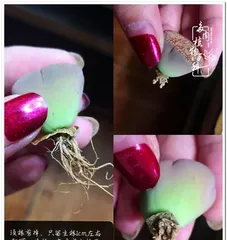Keywords: Rescue Measures

Lithops are a beautiful type of succulent, however, sometimes they may experience stunted growth, which has a significant impact on the plant's growth and development. If you have encountered this situation as well, don't worry. This article will introduce you to the methods for rescuing stunted Lithops and care techniques.
What is stunted Lithops?
Stunted Lithops refers to a situation during the growth process where the plant grows slowly, leaves deform, and the color fades, ultimately leading to an abnormal plant morphology.

Causes of stunted Lithops
1. Lack of nutrients in the soil;
2. Insufficient light;
3. Low temperature;

4. Improper water management;
5. Pest and disease infestation.
How to rescue stunted Lithops
1. Replace the soil: Remove the plant and replace it with new soil;
2. Trim leaves: Prune off damaged leaves to make it more aesthetically pleasing;
3. Supplement nutrients: Use appropriate fertilizers to supplement nutrients;
4. Adjust temperature: Maintain a suitable temperature to create a suitable growing environment;
5. Water appropriately: Do not overwater or underwater, maintain suitable moisture;
6. Increase light: Place the plant in a brighter location to increase light exposure;
7. Prevent and control pests and diseases: Discover and take measures in time to prevent infestation.
Care techniques for Lithops
1. Choose suitable soil: Lithops prefer well-draining, loose soil;
2. Suitable temperature: Lithops like a warm, dry environment, with the most suitable growth temperature between 20-30°C;
3. Maintain ventilation: To prevent leaf moisture and mold, maintain ventilation;
4. Water appropriately: Do not overwater or underwater, maintain suitable humidity;
5. Increase light: Lithops like light, place them in a bright location;
6. Fertilize regularly: Lithops need appropriate fertilizer to maintain healthy growth;
7. Prevent infection: Discover and prevent pest and disease infections in a timely manner;
8. Prune in a timely manner: For perennial Lithops, prune in a timely manner to keep them neat and beautiful.
How to prevent stunted Lithops
1. Pay attention to management: Discover and handle problems related to soil, light, temperature, water, and fertilizer in a timely manner;
2. Regular inspection: Regularly check the growth of the plant and handle any problems found in a timely manner;
3. Avoid over-fertilizing: Do not over-fertilize in the hope of making the plant grow faster;
4. Master watering techniques: Master watering techniques, do not overwater or underwater;
5. Prevent pests and diseases: Strengthen preventive measures for the plant and try to avoid infestation as much as possible.
Common problems and solutions for Lithops
1. Root rot: Remove the plant, clear the rotten parts, and replace with new soil;
2. Yellow leaves: Appropriately reduce watering frequency and increase light exposure time;
3. Withered leaves: Appropriately increase watering frequency and increase light exposure time;
4. Black leaf tips: May be due to sunburn on the leaves, move the plant to a shady place;
5. Deformed leaves: May be due to low temperature, move the plant to a warmer place.
Common varieties of Lithops
1. Begonia Lithops: Blooms in autumn with rich and colorful flowers;
2. Colorful Lithops: Leaves have colorful mottled patterns;
3. Jade Lithops: Leaves are jade green, fresh and natural;
4. Tassel Lithops: Leaves hang down, resembling tassels.
How to repot Lithops
1. Dig up the plant: Remove the plant and tidy up the roots;
2. Choose a new pot: Pay attention to the size, material, and drainage performance when choosing a new pot;
3. Add new soil: Pour new soil into the new pot, place the plant in it, and add appropriate fertilizer;
4. Water: Water an appropriate amount, be careful not to overwater.
How to propagate Lithops
1. Stem and leaf cutting method: Insert the stem and leaves into moist sandy soil, keep it moist, and roots will grow in about 2-3 weeks;
2. Leaf cutting method: Insert the leaves into moist sandy soil, keep it moist, and roots will grow in about 2-3 weeks;
3. Grafting method: Graft two Lithops together to make them grow together.
How to properly place Lithops
1. Choose a bright location: Lithops like light, place them in a bright location;
2. Avoid direct sunlight: Avoid exposing the plant to direct sunlight to prevent leaf burn;
3. Maintain ventilation: Maintain ventilation to prevent leaf moisture and mold.
"Beauty" tips for Lithops
1. Regular pruning: Regularly trim leaves to maintain a beautiful plant shape;
2. Pay attention to neatness: Keep the plant neat and orderly, do not let it become messy;
3. Control growth: Control growth in a timely manner to prevent the plant from growing too fast.
Precautions for Lithops
1. Prevent over-fertilizing: Do not over-fertilize in the hope of making the plant grow faster;
2. Prevent pests and diseases: Strengthen preventive measures for the plant to avoid infestation;
3. Pay attention to water: Master watering techniques to avoid overwatering or underwatering.
Common cultivation mistakes
1. Too much and too frequent watering: Lithops do not like too much and too frequent watering;
2. Low temperature: Lithops like a warm environment, do not place them in a place with too low a temperature;
3. Lack of nutrients in the soil: Use appropriate fertilizers to supplement nutrients in the soil.
Secrets to successfully growing Lithops
1. Choose suitable soil: Well-draining, loose soil;
2. Pay attention to temperature and humidity: A warm, dry, and ventilated environment;
3. Master watering techniques: Maintain suitable humidity;
4. Fertilize regularly: Supplement nutrients appropriately;
5. Pay attention to the prevention and control of pests and diseases.
Lithops are a beautiful type of succulent, but they may experience stunted growth during their growth process. This article introduces the rescue methods and care techniques for stunted Lithops, hoping to help everyone better care for their Lithops.